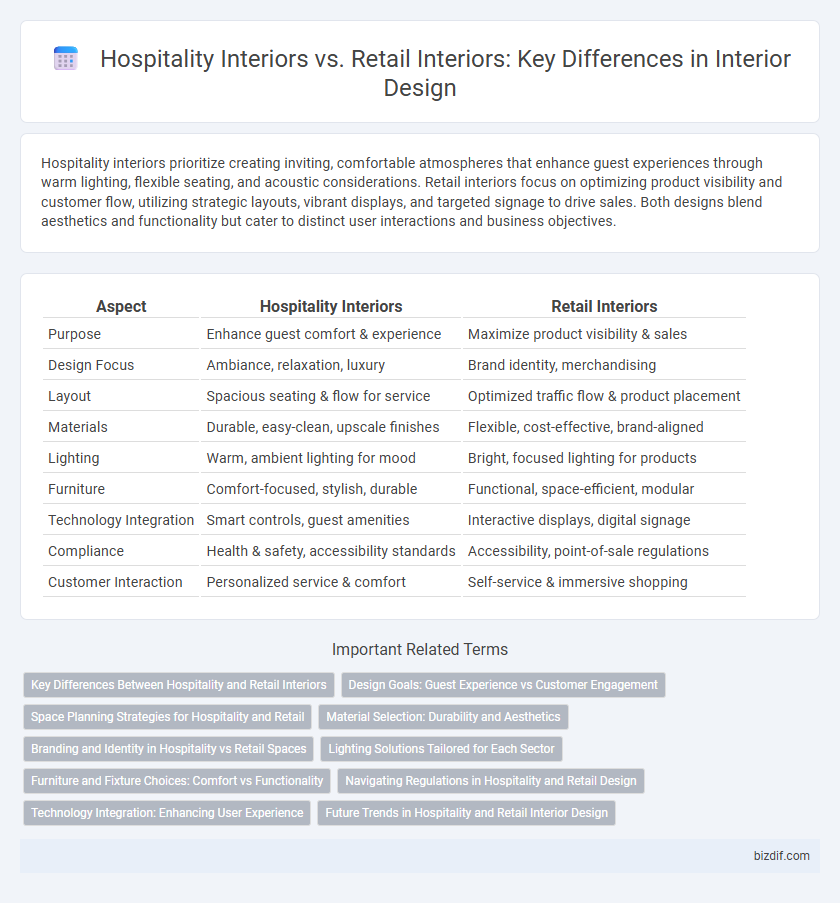Hospitality interiors prioritize creating inviting, comfortable atmospheres that enhance guest experiences through warm lighting, flexible seating, and acoustic considerations. Retail interiors focus on optimizing product visibility and customer flow, utilizing strategic layouts, vibrant displays, and targeted signage to drive sales. Both designs blend aesthetics and functionality but cater to distinct user interactions and business objectives.
Table of Comparison
| Aspect | Hospitality Interiors | Retail Interiors |
|---|---|---|
| Purpose | Enhance guest comfort & experience | Maximize product visibility & sales |
| Design Focus | Ambiance, relaxation, luxury | Brand identity, merchandising |
| Layout | Spacious seating & flow for service | Optimized traffic flow & product placement |
| Materials | Durable, easy-clean, upscale finishes | Flexible, cost-effective, brand-aligned |
| Lighting | Warm, ambient lighting for mood | Bright, focused lighting for products |
| Furniture | Comfort-focused, stylish, durable | Functional, space-efficient, modular |
| Technology Integration | Smart controls, guest amenities | Interactive displays, digital signage |
| Compliance | Health & safety, accessibility standards | Accessibility, point-of-sale regulations |
| Customer Interaction | Personalized service & comfort | Self-service & immersive shopping |
Key Differences Between Hospitality and Retail Interiors
Hospitality interiors prioritize creating immersive atmospheres that enhance comfort and social interaction, incorporating durable materials and flexible lighting to accommodate varying guest needs. Retail interiors focus on maximizing product visibility and customer flow, utilizing strategic shelving, signage, and spatial layout to drive sales and brand engagement. Both require thoughtful design, but hospitality emphasizes experience and relaxation, while retail centers on functionality and purchase facilitation.
Design Goals: Guest Experience vs Customer Engagement
Hospitality interiors prioritize creating a welcoming atmosphere that enhances guest comfort and relaxation, often featuring luxurious materials, ambient lighting, and acoustics tailored for social interaction. Retail interiors focus on customer engagement by designing dynamic spaces that optimize product visibility, encourage browsing, and drive purchasing behaviors through strategic layout and interactive displays. Both sectors utilize design psychology, but hospitality emphasizes emotional well-being while retail targets consumer decision-making and brand connection.
Space Planning Strategies for Hospitality and Retail
Space planning strategies for hospitality interiors emphasize creating fluid circulation paths and flexible seating arrangements to enhance guest comfort and social interaction, while integrating ambient lighting and acoustic elements to foster a welcoming atmosphere. Retail interiors prioritize maximized product visibility and customer flow optimization through strategic fixture placement, clear signage, and defined zoning that encourages prolonged engagement and impulse buying. Both sectors employ tailored layouts that balance aesthetic appeal with functional efficiency, reflecting user behavior and specific business objectives.
Material Selection: Durability and Aesthetics
Hospitality interiors prioritize materials that balance high durability with comfort and aesthetic warmth to endure frequent use while creating inviting atmospheres, often utilizing fabrics, natural woods, and resilient composites. Retail interiors focus on materials that emphasize durability alongside sleek, modern aesthetics to enhance brand identity and product visibility, frequently employing metal, glass, and polished surfaces. Both sectors carefully select materials to ensure longevity and visual appeal but differ in their emphasis on tactile experience versus product showcasing.
Branding and Identity in Hospitality vs Retail Spaces
Hospitality interiors prioritize creating immersive brand experiences through ambience, comfort, and personalized elements that reinforce identity and foster guest loyalty. Retail interiors focus on visual merchandising, product accessibility, and layout optimization to reflect brand values and drive consumer engagement and sales. Both sectors leverage spatial design, materials, and lighting strategically to embody their unique brand narratives and connect emotionally with their target audience.
Lighting Solutions Tailored for Each Sector
Hospitality interiors demand lighting solutions that create warm, inviting atmospheres through adjustable ambient lights and accent fixtures enhancing guest comfort and mood. Retail interiors require bright, focused lighting strategies such as spotlights and LED displays to highlight products, improve color accuracy, and drive customer attention to merchandise. Both sectors benefit from energy-efficient, smart lighting systems tailored to spatial needs and user experience but prioritize different emotional and functional effects.
Furniture and Fixture Choices: Comfort vs Functionality
Hospitality interiors prioritize furniture and fixtures that enhance comfort and create a welcoming atmosphere, often featuring plush seating, warm lighting, and ergonomic designs to encourage relaxation. Retail interiors emphasize functionality with durable, space-efficient fixtures and modular furniture that support high traffic and product display versatility. The choice between comfort and functionality in these sectors reflects their distinct customer experience goals and usage patterns.
Navigating Regulations in Hospitality and Retail Design
Navigating regulations in hospitality and retail interiors requires understanding distinct compliance standards, with hospitality design emphasizing health and safety codes such as fire safety, accessibility under the ADA, and hygiene regulations essential for guest welfare. Retail interiors prioritize consumer protection laws, zoning regulations, and accessibility to create safe, navigable spaces that enhance shopper experience while adhering to legal standards. Both sectors demand meticulous attention to local building codes and sustainability certifications to ensure functionality, safety, and regulatory compliance.
Technology Integration: Enhancing User Experience
Hospitality interiors leverage advanced technology such as smart room controls, AI-driven concierge services, and immersive audiovisual systems to create personalized and seamless guest experiences. Retail interiors integrate interactive kiosks, augmented reality displays, and data-driven lighting solutions to engage customers and optimize shopping behavior. Both sectors prioritize technology integration to enhance user experience but tailor innovations to suit distinct operational needs and customer interactions.
Future Trends in Hospitality and Retail Interior Design
Future trends in hospitality interiors emphasize immersive technology integration, sustainable materials, and personalized guest experiences through adaptable spaces and biophilic design elements. Retail interiors are shifting towards experiential and interactive layouts, incorporating augmented reality, modular displays, and smart lighting to enhance customer engagement and streamline navigation. Both sectors prioritize flexibility, eco-conscious solutions, and seamless digital-physical integration to meet evolving consumer expectations and drive business growth.
Hospitality interiors vs Retail interiors Infographic

 bizdif.com
bizdif.com